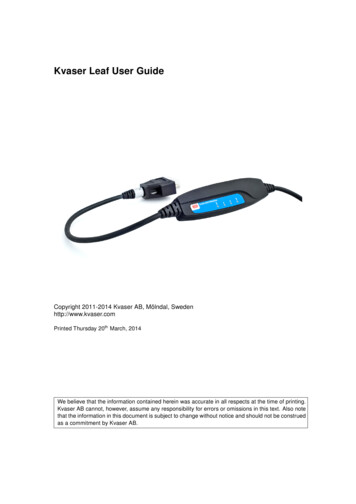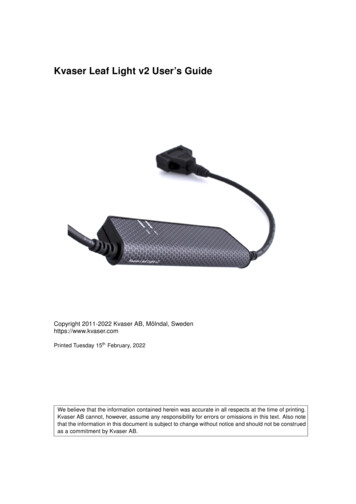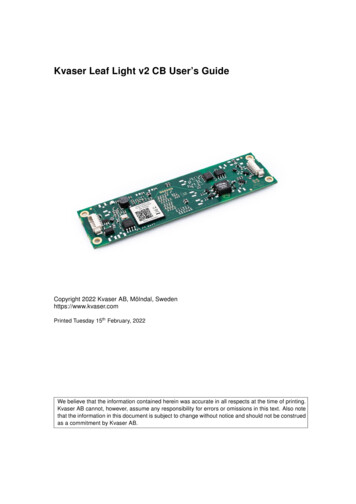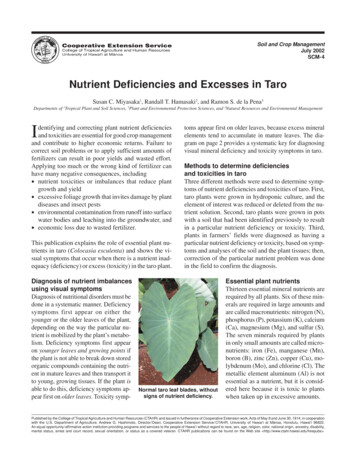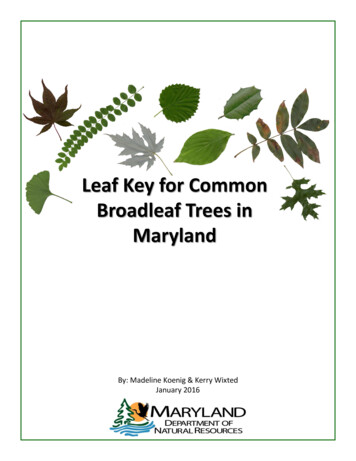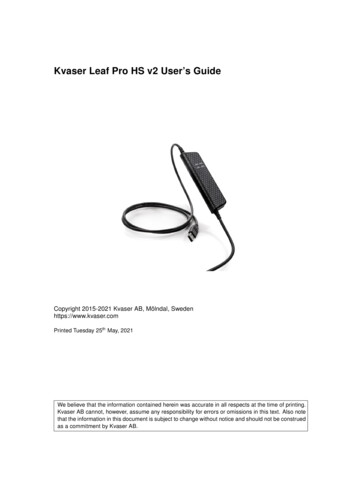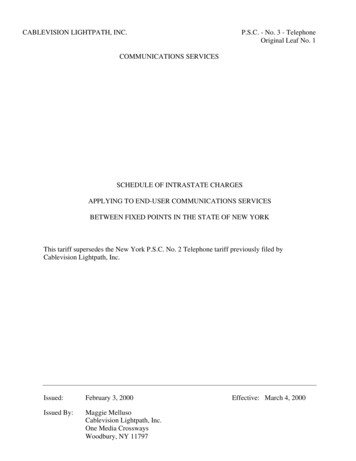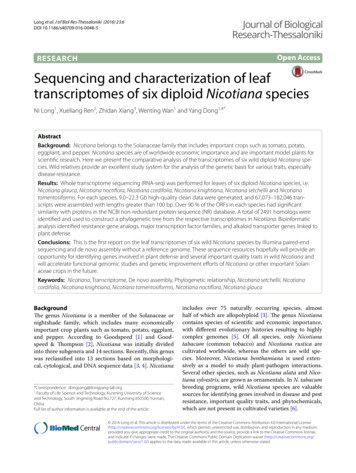
Transcription
Journal of BiologicalResearch-ThessalonikiLong et al. J of Biol Res-Thessaloniki (2016) 23:6DOI 10.1186/s40709-016-0048-5Open AccessRESEARCHSequencing and characterization of leaftranscriptomes of six diploid Nicotiana speciesNi Long1, Xueliang Ren2, Zhidan Xiang3, Wenting Wan1 and Yang Dong1,4*AbstractBackground: Nicotiana belongs to the Solanaceae family that includes important crops such as tomato, potato,eggplant, and pepper. Nicotiana species are of worldwide economic importance and are important model plants forscientific research. Here we present the comparative analysis of the transcriptomes of six wild diploid Nicotiana species. Wild relatives provide an excellent study system for the analysis of the genetic basis for various traits, especiallydisease resistance.Results: Whole transcriptome sequencing (RNA-seq) was performed for leaves of six diploid Nicotiana species, i.e.Nicotiana glauca, Nicotiana noctiflora, Nicotiana cordifolia, Nicotiana knightiana, Nicotiana setchellii and Nicotianatomentosiformis. For each species, 9.0–22.3 Gb high-quality clean data were generated, and 67,073–182,046 transcripts were assembled with lengths greater than 100 bp. Over 90 % of the ORFs in each species had significantsimilarity with proteins in the NCBI non-redundant protein sequence (NR) database. A total of 2491 homologs wereidentified and used to construct a phylogenetic tree from the respective transcriptomes in Nicotiana. Bioinformaticanalysis identified resistance gene analogs, major transcription factor families, and alkaloid transporter genes linked toplant defense.Conclusions: This is the first report on the leaf transcriptomes of six wild Nicotiana species by Illumina paired-endsequencing and de novo assembly without a reference genome. These sequence resources hopefully will provide anopportunity for identifying genes involved in plant defense and several important quality traits in wild Nicotiana andwill accelerate functional genomic studies and genetic improvement efforts of Nicotiana or other important Solanaceae crops in the future.Keywords: Nicotiana, Transcriptome, De novo assembly, Phylogenetic relationship, Nicotiana setchellii, Nicotianacordifolia, Nicotiana knightiana, Nicotiana tomentosiformis, Nicotiana noctiflora, Nicotiana glaucaBackgroundThe genus Nicotiana is a member of the Solanaceae ornightshade family, which includes many economicallyimportant crop plants such as tomato, potato, eggplant,and pepper. According to Goodspeed [1] and Goodspeed & Thompson [2], Nicotiana was initially dividedinto three subgenera and 14 sections. Recently, this genuswas reclassified into 13 sections based on morphological, cytological, and DNA sequence data [3, 4]. Nicotiana*Correspondence: dongyang@dongyang‑lab.org1Faculty of Life Science and Technology, Kunming University of Scienceand Technology, South Jingming Road No.727, Kunming 650500, Yunnan,ChinaFull list of author information is available at the end of the articleincludes over 75 naturally occurring species, almosthalf of which are allopolyploid [3]. The genus Nicotianacontains species of scientific and economic importance,with different evolutionary histories resulting to highlycomplex genomes [5]. Of all species, only Nicotianatabacum (common tobacco) and Nicotiana rustica arecultivated worldwide, whereas the others are wild species. Moreover, Nicotiana benthamiana is used extensively as a model to study plant-pathogen interactions.Several other species, such as Nicotiana alata and Nicotiana sylvestris, are grown as ornamentals. In N. tabacumbreeding programs, wild Nicotiana species are valuablesources for identifying genes involved in disease and pestresistance, important quality traits, and phytochemicals,which are not present in cultivated varieties [6]. 2016 Long et al. This article is distributed under the terms of the Creative Commons Attribution 4.0 International /), which permits unrestricted use, distribution, and reproduction in any medium,provided you give appropriate credit to the original author(s) and the source, provide a link to the Creative Commons license,and indicate if changes were made. The Creative Commons Public Domain Dedication waiver ) applies to the data made available in this article, unless otherwise stated.
Long et al. J of Biol Res-Thessaloniki (2016) 23:6Plants are constantly under the attack of bacteria,fungi, viruses, nematodes and insect pests. Some ofthem have successfully invaded crop plants, causing diseases and reducing crop quality and yield. To protectagainst pathogens, plants have evolved various defensemechanisms. Plant disease resistance (R) genes play akey role in defending plants from a range of pathogens.For instance, N genes from tobacco confer resistance totobacco mosaic virus (TMV) [7]. In recent years, a set of112 known and 104,310 putative R genes fighting against122 different pathogens have been identified in 233 plantspecies [8]. Most of the characterized R genes share a fewhighly conserved domains, including nucleotide bindingsite (NBS), leucine-rich repeat (LRR), Toll/Interleukin-1receptor (TIR) and coiled-coil (CC) domains [9–11].These conservative domains provide convenient and reliable means for rapidly identifying and cloning R genes orresistance gene analogs (RGAs).Identification of Nicotiana R genes and RGAs cannot only help elucidate the molecular mechanisms ofhost-pathogen interaction, but also benefit breedingprograms for disease resistance in Nicotiana and otherimportant Solanaceae crops. Transcriptomic sequencescan be useful substitutes for gene discovery in specieswithout sequenced genomes. In the past, a large RGApool has been mined from transcriptomic sequences andexpressed sequence tags (ESTs) of coffee [12], Phaseolusvulgaris [13], Curcuma longa [14] and Cocos nucifera[15]. Wild Nicotiana species are known to resist a variety of pathogens. For example, N. glauca has attractivepotentials to resist black root rot (BRR), potato virus Y(PVY), tobacco etch virus (TEV), anthracnose (An), powdery mildew (PM), rattle virus (RV) and tobacco streakvirus (TS) [16–18]. Nicotiana noctiflora is resistant toPM and PVY. Nicotiana cordifolia shows resistance toTS. Nicotiana knightiana manifests high resistance toAn, PM, root knot nematodes (RK), PVY and TEV. Nicotiana setchellii shows resistance to RV and TEV. Nicotiana tomentosiformis is resistant to cyst nematodes (CN),RK, RV and TEV [16, 17]. These observations suggestthat wild Nicotiana species are excellent depositories ofR genes and RGAs, but relevant analyses of these geneshave been lacking.In Nicotiana species, alkaloids (e.g. nicotine) arebelieved to function as a chemical defense mechanismagainst pathogens and herbivores. Nicotine and relatedpyridine alkaloids are synthesized in the tobacco root andthen translocated to the aerial parts of the plant [19, 20].Thus the translocation of nicotine from the root to theleaves is very important in tobacco defenses.Comparative studies of closely related species canadvance our understanding of the genetic architecture ofadaptive traits. So far, such studies have been very limitedPage 2 of 12for several crops including tobacco. This is mainly due tothe lack of genomic resources hampering the development of genetic markers for investigating species divergence, adaptation and demographic processes in naturalpopulations.In the present study, we selected six wild Nicotiana species for analyses, which included N. glauca, N. noctiflora,N. cordifolia, N. knightiana, N. setchellii, and N. tomentosiformis. These diploid Nicotiana species (all with chromosome numbers of 2n 24) were chosen because theyare repositories of pathogen resistant genes (Table 1).The six wild Nicotiana species belong to three sections:Noctiflorae, Paniculatae and Tomentosae. Trait introgression from wild relatives has been used to improve cropspecies. For example, characters from at least 13 different species have been transferred into tobacco [4]. Withadvances in next-generation sequencing (NGS) technologies, genomic data for several Nicotiana species havebecome available [21–25]. These data revealed that someNicotiana genomes are large compared with other Solanaceae species such as the tomato [5]. For most wild Nicotiana species, very few genomic sequences are currentlyavailable. In this study, we performed transcriptomesequencing using the Illumina paired-end sequencingtechnique with the aim of identifying expressed RGAs,transcription factors important in plant defense, andalkaloid transporter genes by data mining. Our resultswill provide a useful basis for future identification andcloning of interest genes in wild Nicotiana and contribute to the improvement of cultivated tobacco and otherimportant Solanaceae crops.Results and discussionAssembly of RNA‑seq reads and evaluationThe Illumina paired-end sequencing yielded 100 bppaired-end independent reads from each insert of cDNA.After stringent quality assessment and data filtering,reads with Q20 bases (those with a base quality greaterTable 1 Summary of the six wild Nicotiana species investigated in this studySpeciesSectionsSubgenus Resistance to diseasesN. glaucaNoctifloraePetunioides BRR, An, PM, RV, TEV, TS,PVYPetunioides PM, PVYN. noctifloraNoctifloraeN. cordifoliaPaniculatae RusticaTSN. knightianaPaniculatae RusticaAn, PM, RK, TEV, PVYN. setchelliiTomentosae TabacumN. tomentosiformis Tomentosae TabacumRV, TEVCN, RK, RV, TEVBRR black root rot, An anthracnose, CN cyst nematodes, PM powdery mildew, RKroot-knot nematodes, RV rattle virus, TS tobacco streak virus, PVY potato virus Y,TEV tobacco etch virus
Long et al. J of Biol Res-Thessaloniki (2016) 23:6Page 3 of 12than 20) were selected as high quality reads for furtheranalysis. In this study, 9.0–22.3 Gb of clean data were generated for each sample (Additional file 1). Due to the lackof reference genome information, Trinity was used for denovo assembly of the six wild Nicotiana species [26]. Weultimately obtained 182,046, 146,188, 134,519, 67,073,102,935 and 117,640 transcripts with length 100 bpfor N. glauca, N. noctiflora, N. cordifolia, N. knightiana,N. setchellii and N. tomentosiformis, respectively (Additional file 1). Subsequently, open reading frames (ORFs)were predicted and the transcripts were translated intopeptides culled at a minimum length of 100 amino acids.Only ORFs longer than 300 bp were considered to bepossible protein-encoding transcripts and 33,995–79,449ORFs were obtained through this process for the studiedspecies (see Additional file 2). Although the ORFs of thesix wild Nicotiana species varied within a large range,from 33,995 to 79,449, after removing redundancy dueto alternative splicing isoforms, the ORFs ranged from22,168 to 29,356 (N. glauca 22,934, N. noctiflora 26,788,N. cordifolia 29,356, N. knightiana 22,168, N. setchellii26,579 and N. tomentosiformis 24,213).In the absence of a reference genome, evaluatingthe quality of the de novo assembled transcriptomesbecomes a tedious job. To resolve it, we marked N.tomentosiformis as a reference. A total of 53,753 reportedpeptide sequences (ftp://solgenomics.net/genomes/Nicotiana tomentosiformis/annotation/, Accessed 27th Apr2015) were blasted [27] against our predicted ORFs of N.tomentosiformis using BLASTp with a cut-off e-value of10 5. A total of 50,390 (93.74 %) N. tomentosiformis proteins had a BLAST hit in our ORFs and 32,761 (60.95 %)proteins showed 90 % identity with more than 50 %matched length of the corresponding proteins, whichsuggests our assembly should be largely complete.Moreover, ORFs were compared to the core eukaryotegene (CEG) set of 248 proteins from six reference species [28] to assess the quality of each transcriptome. TheCEGs were well-represented in the assembled transcriptomes of the N. glauca, N. noctiflora, N. cordifolia, N.knightiana, N. setchellii, N. tomentosiformis, with significant matches (alignment length 50 % CEG length ande-value 10 5) to 87.10, 92.34, 91.94, 89.92, 90.73 and91.53 % of the CEGs, respectively. This indicated that thequality and completeness of our transcriptome assemblies were high enough for subsequent analyses. Thesetranscriptome sequences may greatly enrich the Nicotiana sequence database, and will be useful in trait-relatedgene mining, such as the identification of plant defensegenes.Transcriptome annotation and expression analysisTo obtain the most informative and complete annotation, ORFs from six species of Nicotiana were annotatedseparately. Sequence similarity searches were conductedagainst the NCBI NR and Swiss-Prot databases using theBLASTp algorithm with a cutoff e-value of 10 5. Usingthis approach, 94.68–97.43 % ORFs showed homologywith sequences in the NR database (Table 2) and 71.06–77.76 % ORFs returned significant matches in the SwissProt database (Table 2). The e-value distribution of thetop hits in the Swiss-Prot database showed that 60.78 %of the mapped sequences had a strong homology (smallerthan 10 5, Additional file 3). The remaining un-annotatedORFs appeared to be either Nicotiana-specific genesor homologous genes with unknown functions in otherspecies.Besides, a higher ( 90 %) match rate in the NR database was shown by ORFs with 200 aa in length, whereasORFs shorter than 200 aa exhibited a lower match rate(Fig. 1). An almost similar match rate pattern wasobserved in the annotation for Swiss-Prot database(Additional file 4).The expression level of each ORF from six wild Nicotiana species was normalized and quantified by the FPKM(fragments per kilobase per million sequenced reads)Table 2 Summary of functional annotation of predicted ORFsN. glaucaN. noctifloraN. cordifoliaN. knightianaN. setchelliiN. ge96.50 %95.88 %94.68 %97.43 %95.42 %96.40 entage72.98 %73.83 %71.06 %77.76 %73.61 %75.56 e57.14 %57.89 %55.24 %60.12 %56.35 %58.09 5.80 %56.07 %54.47 %59.92 %56.84 %51.94 %
Long et al. J of Biol Res-Thessaloniki (2016) 23:6Page 4 of 12Fig. 1 Comparison of ORF length between hit and no hit proteins in NR database. For N. glauca, N. noctiflora, N. cordifolia, N. knightiana, N. setchellii,N. tomentosiformis, longer ORFs were more likely to have BLASTp homologs in protein databasemethod (Additional file 5). The ORFs with FPKM 1 wereconsidered to be unexpressed, ORFs with FPKM valuesbetween 1 and 3 were considered lowly expressed, thosebetween 3 and 15 were considered expressed at mediumlevels, and those with FPKM values 60 were considered highly expressed (Table 3). The top 20 ORFs withhighest FPKM values for each species can be seen inAdditional file 6. These ORFs either encode chloroplastproteins or play role in photosynthesis. These resultsare consistent with the fact that leaves are the plant’smain photosynthetic organs.Phylogenetic analysisLarge-scale transcriptome data are a potential sourceof information for multigene phylogenetic analysis (thephylogenomic approach). In this study, 2491 single copyorthologs were identified and two phylogenetic treeswere constructed by the neighbor-joining (NJ) methodin Phylip [29] (Fig. 2) and maximum likelihood (ML)method in PhyML [30] (Additional file 7). The two phylogenies showed identical topologies. Earlier, Goodspeedplaced N. glauca in the section Paniculatae based onevidence from morphology, cytology, biogeography, andcrossing experiments [31]. Later, N. glauca was placedin the section Noctiflorae based on analysis of sequencesfrom internal transcribed spacer (ITS) of nuclear ribosomal DNA (nrDNA) [3, 32]. Current phylogenetic analysisof the transcriptomes from six diploid species of Nicotiana with Solanum lycopersicum (tomato) as an outgroupsupported the Noctiflorae, Paniculatae, and Tomentoaseclades. The phylogenetic trees obtained in the currentstudy placed N. glauca in the section Noctiflorae, supporting the results of previous works by Chase et al. [32].and Knapp et al. [3].
Long et al. J of Biol Res-Thessaloniki (2016) 23:6Page 5 of 12Table 3 Distribution of ORF expressions in six wild Nicotiana speciesFPKM intervalN. glaucaN. noctifloraN. cordifoliaN. knightianaN. setchelliiN. tomentosiformis0–131,857 (48.69 %)28,985 (45.34 %)33,698 (42.41 %)1–311,832 (18.09 %)11,105 (17.37 %)16,828 (21.18 %)6245 (18.37 %)16,346 (30.89 %)18,670 (35.15 %)2936 (8.63 %)11,577 (21.88 %)3–1511,696 (17.88 %)12,299 (19.24 %)11,338 (21.34 %)16,812 (21.16 %)14,986 (44.08 %)13,912 (26.29 %)15–606710 (10.26 %)12,948 (24.37 %)7708 (12.06 %)8232 (10.36 %)6782 (19.95 %)7495 (14.16 %) 603328 (5.09 %)6836 (12.87 %)3833 (5.10 %)3879 (4.88 %)3046 (8.96 %)3586 (6.78 %)3329 (6.27 %)Ratios of ORF number to total ORF number are presented in parenthesesFPKM fragments per kilobase per million sequenced readsSectionN. cordifoliaN. knightianaN. setchelliiN. tomentosiformisN. glaucaN. noctifloraPaniculataeTomentosaeNoctiflorae0.01Fig. 2 Phylogenetic tree based on the transcriptomes of the six wildNicotiana species and S. lycopersicum. Phylogenetic tree was constructed using the neighbor-joining method with 1000 bootstraps.Bootstrap support is shown at the nodesFunctional classification by KEGGORFs of six wild Nicotiana species were compared withKEGG (Kyoto Encyclopedia of Genes and Genomes)database using BLASTp with an e-value less than 10 5,and the corresponding pathways were established. Forthe six species, 55.24–60.12 % of ORFs were successfullyannotated to KEGG pathways (Table 2). Genes within thesame pathway usually cooperate with each other to exercise their biological function, and hence pathway-basedanalysis contributes to the exploration of biological functions and interactions of genes [33]. The sequence annotation in KEGG largely contained metabolic pathways ofmajor biomolecules such as carbohydrates, amino acids,lipids, nucleotides, etc. (Fig. 3a). The metabolic pathwayswith most representation by proteins were those of carbohydrate metabolism and amino acid metabolism. Inthe secondary metabolism, for N. glauca, N. noctiflora, N.cordifolia, N. knightiana, N. setchellii, N. tomentosiformis,687, 817, 1064, 518, 779 and 677 proteins were classified into 14 subcategories, respectively (Fig. 3b). Amongthem, the cluster for “Phenylpropanoid biosynthesis”represents the largest group followed by “Stilbenoid,diarylheptanoid and gingerol biosynthesis”. The phenypropanoid pathway is often considered to be involved inplant resistance [34]. Flavonoids and glucosinolates aresecondary metabolites that play important roles in protecting plants against pathogens. We also found unigenesinvolved in the biosynthesis of flavonoid and glucosinolate. The results will facilitate the discovery of novelgenes involved in the specific metabolic pathways andsecondary metabolic pathways and will provide a valuable resource for investigating the defense-related pathways in Nicotiana and other Solanaceae species.Functional classification by GOGene ontology (GO) [35] provides ontologies of definedterms representing gene product properties anddescribes gene products in terms of their associated biological processes, cellular components, and molecularfunctions. In this study, 36,508, 35,846, 43,279, 20,370,30,079 and 27,592 annotated ORFs corresponding toN. glauca, N. noctiflora, N. cordifolia, N. knightiana,N. setchellii, and N. tomentosiformis, respectively, wereassigned to one or more sub-categories of GO terms. TheGO terms of the subcategories are presented in Fig. 4.For the six wild Nicotiana species, among these groups,genes involved in “metabolic process” and “cellular process” were the most highly represented in the biologicalprocess category. Genes involved in other important biological processes such as biological regulation, responseto stimulus, and anatomical structure formation processwere also identified. Furthermore, a relatively large number of sequences were found to be involved in the metabolism of pigmentation. Within the cellular componentscategory, “cell” and “cell parts” were the most highlyrepresented groups. The molecular function categorycomprised proteins involved in “binding” and “catalyticactivity”. These six wild Nicotiana transcriptomes sharedbroad similarities in the three main categories and manysubcategories except viral reproduction.Identification of NBS encoding genes and defenseresponse associated transcription factorsThe majority of disease resistance genes in plants contain a nucleotide-binding site and leucine-rich repeat(NBS-LRR) domain [36, 37], which confers resistance to
Long et al. J of Biol Res-Thessaloniki (2016) 23:6Page 6 of 12abFig. 3 Pathway assignment based on KEGG from the six wild Nicotiana species. a Classification based on metabolism categories; b classificationbased on secondary metabolism categories
ce celle extrae ll partm xtrac cellu nvelopememacromeollular relagr regiobran lecula ion p ne-enartclosrecompled lum xorgaorganeennelle lleantio partxidbin antelectr catadlyingenzy on c tice me re arriemomlecutalallochapgulatorrnutrier transedronestrcertrans ucturant reseul olervoirtrancsription mculeanatolation regulamicatorel strutra gulatorbiolocture fonsporterrceationcellullular co biologgicical adrmlar co mpon al re hesiompo ent b gulati nnent ioge onnesrgcelloularanizatioisdproc neestab veloesslishm pmenent o tal prodeathf loca cesslizationmultic mu meta localigrowthellula lti-org bolic p zationr org anism roceanism pro ssceapig l proc ssrepro repmentatieossresp ductiveroductiononp c nevirasl e to stirorepro mulusssduction0Nicotiana cordifolia100.111370.0010.01Cellular Component Molecular FunctionNicotiana setchellii100.11Cellular Component Molecular Function950.0010.01cell pcellarten eex extralopemactrroacelluclaellular vrememrbranmolecularegion gpione-enartrclosecompled lum xorgaorganeellnneeantiolle partxidbindainntgceenzylectronactalytice me re arriermomlecutalallochapgulatorr tra eronns utrie nsdu etranstructurant reservcercripti l mole oirtroanslati n reg culeanatoon re ulatormical strutra gulatobiolocture fonsporterrcellurmgcellu lar co biologicical adh ationlar co mpon al re esionmpo ent b gulatinent ioge onnesrgcelloularanizatioisproc nestabdeveloesslishm pmenent o tal prodeathf loca cesslizationmultic mu metab localigzrowthellula lti\-org olic p ationr org anism rocesanism pro scapig l proceessrepro repmentatiossrodduresp ctive uctiononsenpto stirocessmulus0.010Biological Processfungi, bacteria, viruses, and nematodes. In plants, basedon the presence or absence of a TIR homology region atthe N-terminus, the NBS-LRR genes can be subdividedinto two main groups: TIR-NBS-LRR and non-TIR-NBSLRR. The latter may have a coiled-coil (CC) motif in theN-terminal region and can be called as CC-NBS-LRR.Biological ProcessBiological Process30079Percent of genes432791000100Nicotiana noctiflora100.111130.0010.01Cellular Component Molecular FunctionNicotiana knightiana100.11640.0010.01Cellular Component Molecular FunctionNicotiana tomentosiformis1010.1Cellular Component Molecular Function870.0010.01Number of genes100Number of genesCellular Component Molecular Function36508Number of genes100115Number of genes10Percent of genes0.001cell pcellarten eex extralopemactrroacelluclaellular vrememrbranmolecularegion gpione-enartrclosecompled lum xorgaorganeellnneeantiolle partxidbindainntgceenzylectronactalytice me re arriermomlecutalallochapgulatorr tra eronns utrie nsdu etranstructurant reservcercripti l mole oirtroanslati n reg culeanatoon re ulatormical strutra gulatobiolocture fonsporterrcellurmgcellu lar co biologicical adh ationlar co mpon al re esionmpo ent b gulatinent ioge onnesrgcelloularanizatioisproc nestabdeveloesslishm pmenent o tal prodeathf loca cesslizationmultic mu metab localigzrowthellula lti\-org olic p ationr org anism rocesanism pro scapig l proceessrepro repmentatiossrodduresp ctive uctiononsenpto stirocessmulusPercent of genes0.1Number of genescell pcellextraextrace enacular veloprtmemmacromeollularllreg ebran lecula giorenn ioe-enartclosrecomppled lu xorgaorganmeennelle llepartvir gcme re carriememole talloc gula rcuhatonutrlaier tranpseronerutransstructurant resdervcoercripti l moleirtroanslati n reg culeanatoon re ulatomical strutransgulatorrctubioprecrm ortercelleullular co biolologgical foadh ationlar co mpo ical resiompo nent b guenent iogelationnrgan nesiscelloizatiouladrestab eveloproc nesslishm pmenent o tal prodeathf loca ceslizati solo grow nmultic mu meta loccaolizatiothellula lti-org bolic motionr org anism proce nanism pro sscp al pro essrepro reigpmentactiessresp ductiveroductiononseoviral to sptirocesnsrepro muluducti son1Number of genesPercent of genes100Nicotiana glaucaPercent of genesce celle extrae ll partm xtrac cellu nvelopememacromeollular relagr regiobran lecula ion p ne-enartclosrecompled lum xorgaorganeennelle lleantio partxidbin antelectr catadlyingenzy on c tice me re arriemomlecutalallochapgulatorrnutrier transedronestrcertrans ucturant reseul olervoirtrancsription mculeanatolation regulamicatorel strutra gulatorbiolocture fonsporterrceationcellullular co biologgicical adrmlar co mpon al re hesiompo ent b gulati nnent ioge onnesrgcelloularanizatioisdproc neestab veloesslishm pmenent o tal prodeathf loca cesslizationmultic mu meta localigrowthellula lti-org bolic p zationr org anism roceanism pro ssceapig l proc ssrepro repmentatieossresp ductiveroductiononp c nevirasl e to stirorepro mulusssduction100ce cellen ll partex extram trace cellu velopememacromollular relagr regiobran lecula ion p ne-enartclosrecompled lum xorgaorganeellnnelle eantio partxidbin antelectr catadlyingenzy on c tice me re arriermomlecutalallochapgulatornutrier transedroneustranstructurant reservcerl ole oirtrancsription mculeanatolation regulamicaregu torl structuretranspolatorbiologform rtercecellullular co biologicical adh ationlar co mpon al re esionmpo ent b gulatinent ioge onorga nesiscellular pnizationroceestabdevelosslishm pmenent o tal prodeathf loca cesslizationmultic mu metab localigzrowthellula lti\-org olic p ationr org anism rocesanism pro scapig l proceessrepro repmentatiossresp ductiveroductiononsenpto stirocessmulusPercent of genesLong et al. J of Biol Res-Thessaloniki (2016) 23:6Page 7 of 12358460Biological Process203700Biological Process275920Fig. 4 Histogram presentation of GO classification. The GO annotation results from the ORFs of six Nicotiana species are summarized in three maincategories: biological process, cellular component and molecular function. The right y-axis indicates the number of genes in a category. The lefty-axis indicates the percentage of a specific category of genes in that main categoryBiological ProcessTo control diseases in certain agriculturally importantplants, the identification of resistance genes from theirless susceptible relatives has been the top priority in cropbreeding programs. In the case of Solanaceae species, thepepper Bs2 gene with NBS-LRR domain was introducedinto tomato lines to develop resistance against bacterial
Long et al. J of Biol Res-Thessaloniki (2016) 23:6Page 8 of 12spot disease [38]. In tobacco, the TIR-NBS-LRR encoding N gene was introduced into N. benthamiana, whichresulted in the acquirement of hypersensitivity responseto tobacco mosaic virus (TMV) [39].In this study, after going through a filtering process,87–173 unigenes encoding NBS domains were identifiedfrom the six wild Nicotiana species. These NBS-encodinggenes were classified into six classes on the presence orabsence of CC domain, TIR domain, and/or LRR domain.These six classes include CC-NBS-LRR, CC-NBS, TIRNBS-LRR, TIR-NBS, NBS-LRR, and NBS (Table 4). TheNBS class was the most represented class (61–113 unigenes) for all six species in the present study. The TIRNBS class had 3–8 unigenes for each species, and theNBS-LRR class had 5–14 unigenes (0 for N. tomentosiformis). Additionally, 2–11 unigenes (0 for N. cordifolia)were predicted to encode TIR-NBS-LRR, 11–31 unigeneswere identified as CC-NBS, and 3–7 unigenes containedCC-NBS-LRR. The candidate R genes will enhance ourknowledge about the mechanisms of disease resistance inSolanaceae species and help breed novel disease resistantvarieties.Transcription factors (TFs) are also important in disease resistance. They bind to the promoters of resistancegenes and regulate their expression. The TFs related todefense or disease resistance mainly belong to the MYB[40], WRKY [41], bZIP [42] and Whirly [43] families.Overexpression of the defense-related TFs has improveddisease resistance in many transgenic crops [44]. By usingPfam annotations, we identified 439–618 candidate unigenes matching the defense-related TFs in the six wildspecies of Nicotiana (Table 5). These candidate TFs willbe potential targets for developing the resistant lines oftobacco and other Solanaceae crops.Identification of alkaloid transporter genesAlkaloids are mainly produced in the root and thentranslocated via xylem transport towards the aerial parts.These toxic chemicals function as part of the chemical defense against invaders [19, 20]. To date, the plantalkaloid transporters are mainly characterized into theATP-binding cassette (ABC) protein, multidrug andtoxic compound extrusion (MATE), and purine permease (PUP) families. Some transporters were found tobe required for the efficient biosynthesis of alkaloids inplants [45]. In tobacco, several alkaloid transporter geneshave been identified, such as tobacco jasmonate-inducible alkaloid tranporter1 (Nt-JAT1), Nt-JAT2, tobacconicotine uptake permease1 (Nt-NUP1), NtMATE1 andNtMATE2 [46–50].In the present study, we began our investigation bysearching the assembled transcriptome for orthologous genes to k
After stringent quality assessment and data filtering, reads with Q20 bases (those with a base quality greater Table1 Summary of the six wild Nicotiana species investi-gated in this study BRR black root rot, An anthracnose, CN cyst nematodes, PM powdery mildew, RK root-knot nematodes, RV rattle virus, TS tobacco streak virus, PVY potato virus Y,
